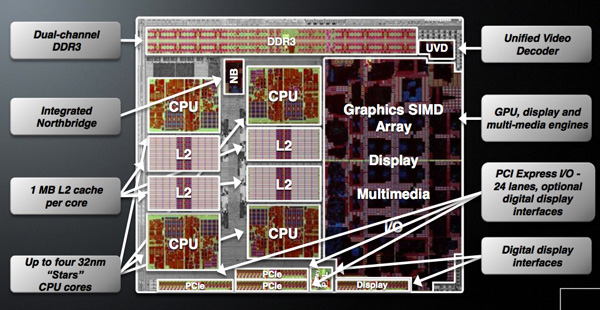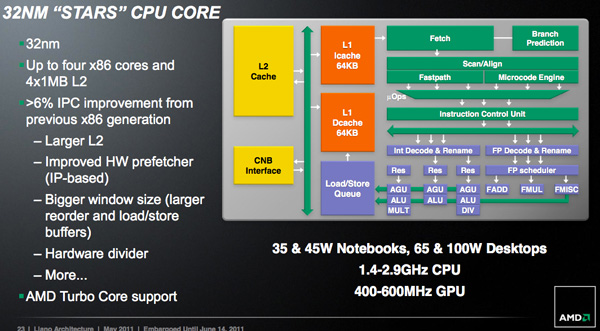The AMD Llano Notebook Review: Competing in the Mobile Market
by Jarred Walton & Anand Lal Shimpi on June 14, 2011 12:01 AM ESTThe Llano A-Series APU
Although Llano is targeted solely at the mainstream, it is home to a number of firsts for AMD. This is AMD's first chip built on a 32nm SOI process at GlobalFoundries, it is AMD's first microprocessor to feature more than a billion transistors, and as you'll soon see it's the first platform with integrated graphics that's actually worth a damn.
AMD is building two distinct versions of Llano, although only one will be available at launch. There's the quad-core, or big Llano, with four 32nm CPU cores and a 400 core GPU. This chip weighs in at 1.45 billion transistors, nearly 50% more than Sandy Bridge. Around half of the chip is dedicated to the GPU however, so those are tightly packed transistors resulting in a die size that's only 5% larger than Sandy Bridge.
| CPU Specification Comparison | ||||||||
| CPU | Manufacturing Process | Cores | Transistor Count | Die Size | ||||
| AMD Llano 4C | 32nm | 4 | 1.45B | 228mm2 | ||||
| AMD Llano 2C | 32nm | 2 | 758M | ? | ||||
| AMD Thuban 6C | 45nm | 6 | 904M | 346mm2 | ||||
| AMD Deneb 4C | 45nm | 4 | 758M | 258mm2 | ||||
| Intel Gulftown 6C | 32nm | 6 | 1.17B | 240mm2 | ||||
| Intel Nehalem/Bloomfield 4C | 45nm | 4 | 731M | 263mm2 | ||||
| Intel Sandy Bridge 4C | 32nm | 4 | 995M | 216mm2 | ||||
| Intel Lynnfield 4C | 45nm | 4 | 774M | 296mm2 | ||||
| Intel Clarkdale 2C | 32nm | 2 | 384M | 81mm2 | ||||
| Intel Sandy Bridge 2C (GT1) | 32nm | 2 | 504M | 131mm2 | ||||
| Intel Sandy Bridge 2C (GT2) | 32nm | 2 | 624M | 149mm2 | ||||
Given the transistor count, big Llano has a deceptively small amount of cache for the CPU cores. There is no large catch-all L3 and definitely no shared SRAM between the CPU and GPU, just a 1MB private L2 cache per core. That's more L2 cache than either the 45nm quad-core Athlon II or Phenom II parts.

Intel's Sandy Bridge die is only ~20% GPU
The little Llano is a 758 million transistor dual-core version with only 240 GPU cores. Cache sizes are unchanged; little Llano is just a smaller version for lower price points. Initially both quad- and dual-core parts will be serviced by the same 1.45B transistor die. Defective chips will have unused cores fused off and will be sold as dual-core parts. This isn't anything unusual, AMD, Intel and NVIDIA all use die harvesting as part of their overall silicon strategy. The key here is that in the coming months AMD will eventually introduce a dedicated little Llano die to avoid wasting fully functional big Llano parts on the dual-core market. This distinction is important as it indicates that AMD isn't relying on die harvesting in the long run but rather has a targeted strategy for separate market segments.
Architecturally AMD has made some minor updates to each Llano core. AMD is promising more than a 6% increase in instructions executed per clock (IPC) for the Llano cores vs. their 45nm Athlon II/Phenom II predecessors. The increase in IPC is due to the larger L2 cache, larger reorder and load/store buffers, new divide hardware, and improved hardware prefetchers.
On average I measured around a 3% performance improvement at the same clock speed as AMD's 45nm parts. Peak performance improved up to 14% however most of the gains were down in the 3—5% range. This is arguably the biggest problem that faces Llano. AMD's Phenom architecture debuted in 2007 and was updated in 2009. Llanos cores have been sitting around for the past 3-4 years with only a mild update while Intel has been through two tocks in the same timeframe. A ~6% increase in IPC isn't anywhere near close enough to bridge the gap left by Nehalem and Sandy Bridge.
Note that this comparison is without AMD's Turbo Core enabled, but more on that later.












177 Comments
View All Comments
ET - Tuesday, June 14, 2011 - link
Legit Reviews found a big difference in game performance between AC and battery (see here: http://www.legitreviews.com/article/1636/5/). This made Llano and the i5 perform about the same on battery in Resident Evil 5. I assume that benchmarks here are on AC, so it would be interesting to test on battery.DXM1 - Tuesday, June 14, 2011 - link
Great Review Anand! Once again we know intel is the best at all things computing. I liked how you included the i7 with 460m up to THREE times in some benchmarks. It was like you kept reminding us and casual consumers that massively more expensive parts perform better... Even if you test the same set-up 3 times in a row!I have to tell you that seeing the 3 intel blue bars on the top made me sigh with relief, I was worried that you may actually compare llano to the parts like i3 and i5 where it is actually meant to compete (like some other silly reviewers). My only gripe is you didnt add i7-2600kand gtx 580 OC'ed as those would have made the gap even wider from the AMD system.
One question I did have for you is, how much does Intel pay nowadays for dishonest reviewing practices? Im short on cash because my job doesnt pay well and I was hoping to open up a website and promote intel just like you. Maybe we could even become partners and link to each other websites I think that would be cool.
PS, could you post how much your integrity was worth before you auctioned it off to Intel? Im sure some of your fans would be eager to know.
Your ex Reader, DXM1
Sharken03 - Tuesday, June 14, 2011 - link
Dont feed this troll, Anandtech is a great hardware site.Jamahl - Tuesday, June 14, 2011 - link
Troll? it's the truth. What was the fucking point in showing 3x identical intel systems except to put 3x intel systems at the top of most benchmarks? It's goddam pathetic.JarredWalton - Tuesday, June 14, 2011 - link
Or, I included these laptops because they're the only ones I still had where I could rerun all the benchmarks (specifically, PCMark 7 and 3DMark 11). Oh, snap! Heaven forbid we think about that. And if you read the 8000+ words of commentary, you'll notice how often we praise Intel's placement at the top of the charts -- and of course we completely ignore when they fall to the bottom of the battery life charts.I wish I had a secret stash of all the laptops I've tested in the last six months, because then I wouldn't have even bothered with including more than one GTX 460M + SNB. But your suggestion that we *not* include laptops because it pushes Llano down is even worse than what we've done. Should we only show laptops where AMD is better? Or maybe just laptops that cost under $700? Maybe we need to dig out an old CULV setup and then benchmark GMA 4500MHD again so we can laugh at Intel's IGP from two years ago?
If you want a look at every laptop we've tested and where Llano falls in the grand scheme of things, I suggest checking into our Mobile Bench results. Hint: it's in the upper part of battery life, and in the middle to lower part of CPU and GPU tests; if you only look at IGPs, though, it's the fastest IGP. Hmm... that sounds a lot like what we said in our conclusion.
pfastovsky - Tuesday, June 14, 2011 - link
JarredI think its a fair comment that asks Anandtech to keep their graphs in an article consistent with the same laptop set across a testing segment. As you said, you had to rerun all the benchmarks so why are the Civ laptops listed so different from Mass Effect, Starcraft etc?
Thanks
ET - Tuesday, June 14, 2011 - link
The comment may be fair, and it's been mentioned before, but accusing Anandtech of being paid by Intel isn't.krumme - Tuesday, June 14, 2011 - link
None of this explains the 3 identical setup.How on earth to you think it looks like?
Its simply utterly pathetic, and an insult at our IQ
I am no fan at this Llano apu, and from the start. think AMD should just have posponed it, and used the capacity for BD and serverspace, but this review is just far out.
The important issue about llano have always been the power profile, and AMD just deliver in spades here. Far beyound expectations. The OEM will sell this like zakate, and the new trinity will not make it significantly better on the market than this with upgraded star cores.
JarredWalton - Tuesday, June 14, 2011 - link
You know what's utterly pathetic and an insult to people's IQ? The suggestion that they can't actually comprehend the graphs. But just to show you that I have no "agenda" and I'm not trying to make AMD's Llano look worse than it is, I have taken a couple hours to go through, remove all the extra data, and regenerate all the graphs. (Yes, folks, creating all of these things does take time and our UI for doing this is not as easy as you might expect.) Of course, not all of the i7-2630QM + GTX 460M notebooks performed equally, so now I've "punished" Intel by showing worse results in some tests. Oh noes!Anyway, thanks for the input and sorry if the inclusion of more laptops was deemed offensive by some. They're just charts, people, and I even colored the "high-end" laptops bright blue so that you could easily filter them out in your mind. You know, something like: "Oh, those lines at the top are bright blue, so they're for quad-core Sandy Bridge laptops that cost about twice what the Llano laptop is expected to cost."
AnandThenMan - Tuesday, June 14, 2011 - link
Although I don't like the approach of the poster taking issue with the graphs, I completely agree on principle. This site has shown a clear pattern of making sure certain hardware always occupies the top of the graphs. Always. And don't insult our intelligence and pretend otherwise, please.Need I also remind people that this site included hand picked, overclocked Nvidia supplied cards (to the insistence of Nvidia) despite a policy that forbids this. I would caution people to take all results on this site with a grain of salt.